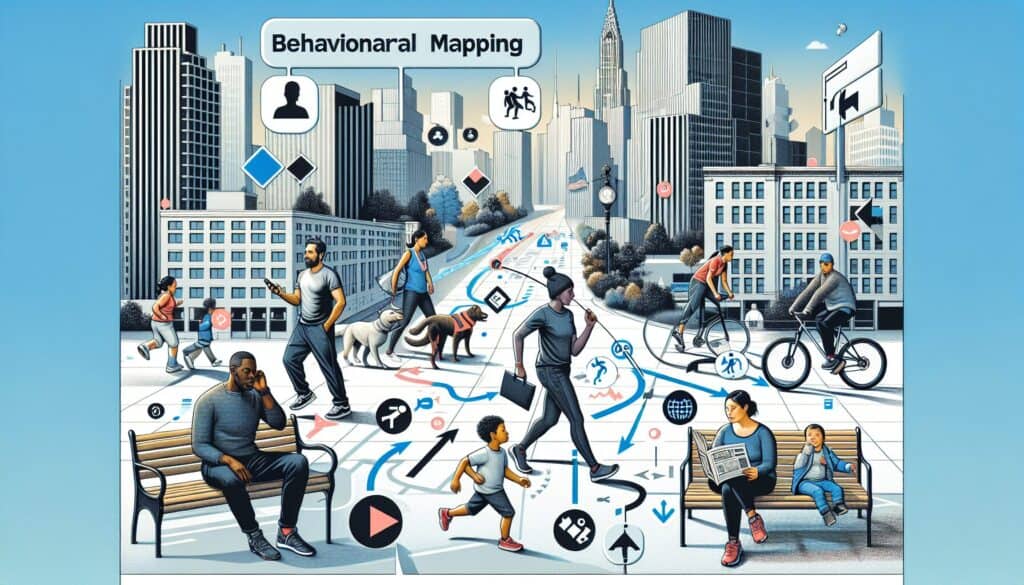Observar y registrar sistemáticamente los comportamientos y movimientos de las personas dentro de un espacio físico específico a lo largo del tiempo para comprender cómo se utiliza el espacio.
- Metodologías: Clientes y marketing, Ideación, Diseño de producto
Mapeo conductual

Mapeo conductual
- Arquitectura, Diseño conductual, Diseño para la sostenibilidad, Pensamiento de diseño, Diseño centrado en el ser humano, Usabilidad, Pruebas de usabilidad, Experiencia de usuario (UX), Interfaz de usuario (UI)
Objetivo:
Cómo se utiliza:
- Los investigadores crean un mapa del entorno y utilizan símbolos o anotaciones para registrar comportamientos específicos, caminos recorridos, interacciones y duración de las actividades en distintos lugares del espacio.
Ventajas
- Proporciona datos objetivos sobre la utilización del espacio y los patrones de comportamiento de los usuarios, ayuda a identificar fallos de diseño u oportunidades de mejora en los entornos físicos, puede informar las decisiones de diseño arquitectónico o de interiores.
Contras
- Puede requerir mucho trabajo y tiempo, la presencia del observador puede influir en el comportamiento (efecto Hawthorne), el análisis de los datos puede ser complejo en función del nivel de detalle, consideraciones éticas relativas a la observación.
Categorías:
- Clientes y marketing, Ergonomía, Diseño de producto
Ideal para:
- Entender cómo interactúan y utilizan las personas los espacios físicos, como tiendas, oficinas, zonas públicas o centros sanitarios, para optimizar el diseño y la funcionalidad.
Behavioral mapping is particularly effective in various industries, including retail, urban planning, workplace design, and healthcare, where understanding user behavior can significantly influence design outcomes. For instance, in retail, this methodology allows designers to analyze customer pathways, dwell times, and interaction hotspots within a store, leading companies like Zara or Manzana to optimize layouts that enhance customer engagement and increase sales. In urban planning, behavioral mapping can be employed in public spaces to examine how individuals interact with amenities, such as parks or transportation hubs, enabling planners to create environments that encourage social interaction or promote safety. In the context of healthcare facilities, it can highlight how patients navigate through hospitals, providing insights that inform the arrangement of departments to reduce stress and improve operational efficiency. This methodology can be initiated by designers, architects, or behavioral scientists and often involves collaboration with stakeholders, including end-users, to ensure that the mapping accurately captures human behavior. These participants may include focus groups or community members who provide qualitative input that complements the quantitative data collected through observation and logging. Importantly, the objective data generated from behavioral mapping can pinpoint not only areas for improvement but also validate successful design decisions, making it a valuable resource during different project phases, from initial concept development through to post-occupancy evaluation. Analyzing the patterns revealed through behavioral mapping equips teams with the information necessary to create environments that not only meet user needs but also encourage positive interactions and experiences within those spaces.
Pasos clave de esta metodología
- Identify specific areas of interest within the environment.
- Select appropriate symbols or notations for behaviors and interactions.
- Determine time intervals for observations.
- Conduct systematic observations in predefined areas.
- Log quantitative data on user interactions and movements.
- Identify patterns and behaviors from the collected data.
- Map the observed behaviors to the spatial layout of the environment.
- Analyze the mapped data to identify areas of concern or opportunity.
- Make design recommendations based on the analysis of user behavior.
Consejos profesionales
- Incorporate real-time data collection tools, such as mobile applications or RFID tags, to enhance the accuracy of behavioral mapping.
- Use heat mapping techniques alongside traditional behavioral mapping to visualize high-traffic areas and interaction points more effectively.
- Regularly update and refine your mapping methodology based on ongoing observations and feedback to capture evolving user behaviors.
Leer y comparar varias metodologías, recomendamos el
> Amplio repositorio de metodologías <
junto con otras más de 400 metodologías.
Sus comentarios sobre esta metodología o información adicional son bienvenidos en la dirección sección de comentarios ↓ , así como cualquier idea o enlace relacionado con la ingeniería.
Contexto histórico
1986
(si se desconoce la fecha o no es relevante, por ejemplo "mecánica de fluidos", se ofrece una estimación redondeada de su notable aparición)

Publicaciones relacionadas
Gestión de operaciones de fabricación (MOM)
Sistema de Ejecución de Fabricación (MES)
Plan de control de la fabricación
Pruebas manuales
Tablas de evaluación de la manipulación manual (MAC)
ManTRA (Herramienta de evaluación de riesgos en las tareas manuales)